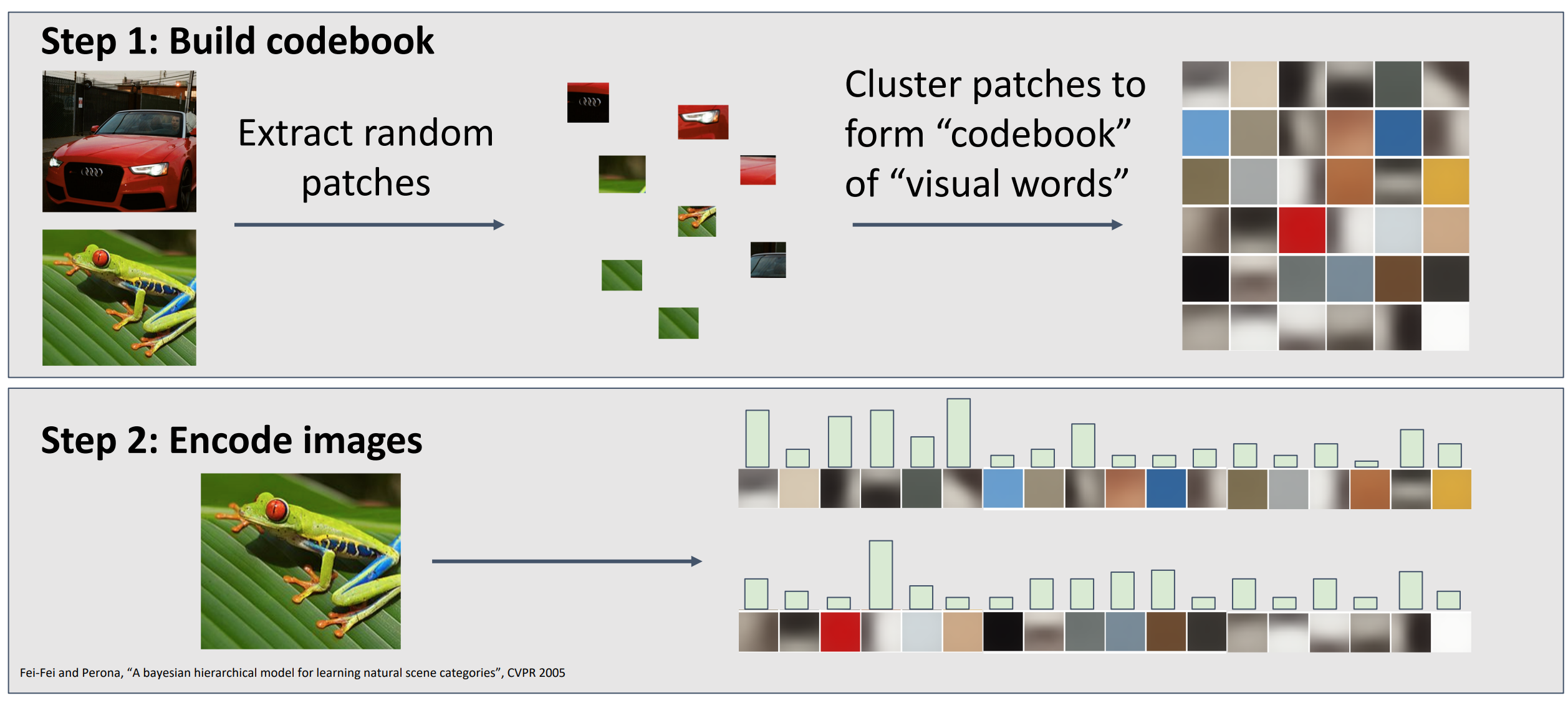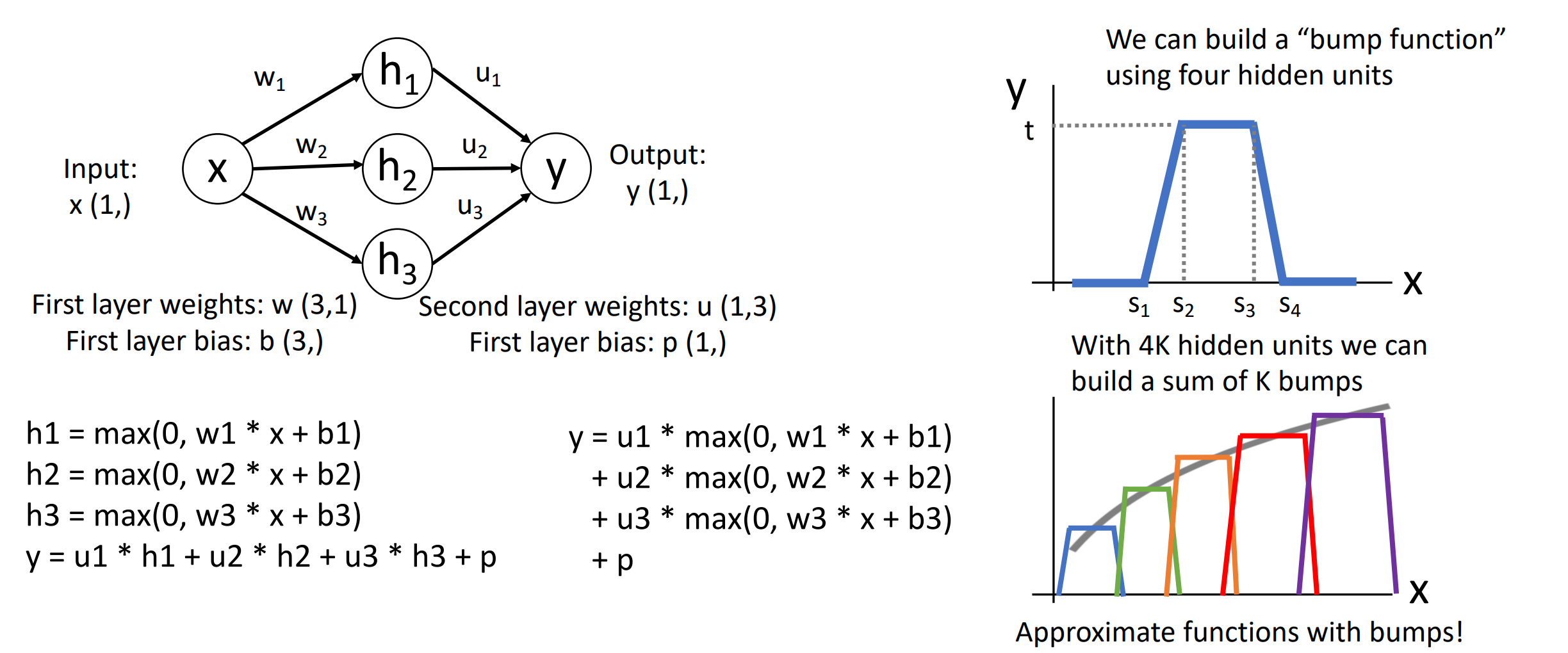Neural Networks¶
Feature transforms¶
- Linear Classifiers aren’t that powerful.
-
在介绍神经网络之前,One solution: Feature Transforms.

在特征空间上进行线性分类,线性分类器在原始空间中可能是非线性的分类器。
-
Example:
-
Color Histogram
Ignores texture, spatial positions.
丢掉了空间信息,只关注颜色信息。
-
Histogram of Oriented Gradients (HoG)
与颜色直方图对偶,丢弃了颜色信息,只关心局部边缘的方向和大小。
Captures texture and position, robust to small image changes
这两种方法要求提前思考如何设计正确类型的特征转换。
-
Bag of Words (Data-Driven!)
-
从训练数据集里,提取大量不同比例和大小的随机补丁 patches,随后聚合 patches 形成 codebooks.
Example

-
Idea:如果图像中存在常见的结构类型,你将学习到某种视觉单词表示,用来捕获识别训练集出现的常见特征。
- 但即使特征提取是数据驱动的, 我们最后的分类是一个大的系统,但实际上这种做法只是系统的一小部分在不断的调整参数,我们希望有更好的方法。 即端到端的系统,接收原始像素,输出预测分数。
-
-
Neural Networks¶
- 相比之下,神经网络相当于同时学习特征和特征空间的分类器。
- 定义:
- Input: \(x\in \mathcal{R}^D\)
- Output: \(f(x)\in \mathcal{R}^C\)
- Example:
- Linear Classifier: \(f=Wx\)
- 2-layer Neural Network: \(f=W_2\max(0, W_1x), W_2\in \mathcal{R}^{C\times H}, W_1\in \mathcal{R}^{H\times D}\)
- 3-Layer Neural Network: \(f=W_3\max(0, W_2\max(0, W_1x+b_1)+b_2)+b_3\)
- 为什么需要 max 函数:我们可以想象权重矩阵在多层之间,表示了前一层的每个元素对下一层的每个元素的影响程度。如果没有非线性函数,那么我们的模型就是一个线性分类器,无法增加表示能力。
Example

-
Fully-connected neural network. Also “Multi-Layer Perceptron” (MLP)
完全连接 / 多层感知机,每一层的所有元素都和下一层的所有元素相连。
-
\((i,j)\) 表示权重矩阵中输入 \(x_i\) 对输出 \(h_j\) 的影响程度。
Example

-
另一种理解:第一层:模板对输入图像 x 的反应程度;第二层:重新组合模板,得到预测分数。
很多时候第一层学习到的模板都难以解释,而是具有某种空间结构。
Example

Deep Neural Networks¶

Activation Functions¶
-
在两个可学习的权重矩阵之间是神经网络的 Activation Functions 激活函数。
- e.g. 在上面的例子中 The function \(ReLU(z)=\max(0,z)\) is called “Rectified Linear Unit”.
-
如果没有激活函数,如 \(s=W_2W_1 x\),那么我们得到的仍然是一个线性分类器,无法增加表示能力。
因此我们需要非线性函数(激活函数)来提高表征能力。 * 常见的激活函数:

ReLU is a good default choice for most problems.
Example

-
Be very careful with brain analogies!
二者有一定差异。
Space Warping¶
为什么我们神经网络的能力这么强大?它是通过空间扭曲的概念来实现的。
-
线性变换:

对于线性不可分的数据,线性变换之后的空间也依然是线性不可分的。
-
但是如果我们使用 ReLU 函数,空间就会有不同的变化。


-
More hidden uints=more capacity.
如果隐藏单元更多,我们可以表示更复杂的边界
Example

有人可能会认为这样的模型太复杂,会过拟合。因此希望降低隐藏层来简化模型,但实际上这并不是一个好主意,你应该使用正则化的方法,而不是降低隐藏层。
Don’t regularize with size; instead use stronger L2.
L2 正则化

Universal Approximation¶
- A neural network with one hidden layer can approximate any function \(f: R^N \rightarrow R^M\) with arbitrary precision.
-
Idea: We can build a “bump function” using four hidden units.
Example

-
Universal approximation tells us:
- Neural nets can represent any function.
- Universal approximation DOES NOT tell us:
- Whether we can actually learn any function with SGD.
- How much data we need to learn a function.
Convex Function¶
- 定义: 如果对于 \(f(tx_1+(1-t)x_2)\leq tf(x_1)+(1-t)f(x_2)\) 都有 \(f(tx_1+(1-t)x_2)\leq tf(x_1)+(1-t)f(x_2)\), 那么\(f:X\subseteq R^N\rightarrow N\) 是凸函数。
-
Intuition: A convex function is a (multidimensional) bowl.

-
Generally speaking, convex functions are easy to optimize: can derive theoretical guarantees about converging to global minimum.
凸优化问题在实践中容易解决,不依赖于初始化。
e.g. Linear classifiers optimize a convex function!
-
Neural net losses sometimes look convex-ish, buf often clearly nonconvex.
- Most neural networks need nonconvex optimization.
- Few or no guarantees about convergence
- Empirically it seems to work anyway
- Active area of research